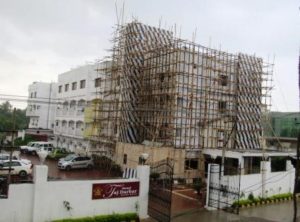Bodh Gaya on a late July evening is balmy with the evening breeze, fresh washed with monsoon showers, but there’s more action here than what meets the off-season tourist’s eye.
A new vegetarian restaurant called Magadh has sprung up opposite the Thai temple, and they serve surprisingly good vegetarian Chinese and south east Asian fare along with the staple Indian veg dishes. Their paneer chilli is made with home processed fresh cottage cheese, and is quite remarkable.
There’s Manu Maharaj, that ‘super-cop’ who’s barged into the banter of the college boys. There’s no triple riding on motorbikes, no mercy for helmet-less riders, and if you’re spotted revving up a motorbike in slippers, a ‘mamu’ will do the dirty on you – the traffic cop (for some reason called ‘mamu’ in local slang – a word that means maternal uncle in Hindi- will slap you with a hefty fine.

One spotted an altercation between some motorcycle wallahs and a couple of guys in a sports car. It was nine in the evening, along a quiet stretch of road. As we approached what appeared to be a heated argument almost coming to blows, one of the motorbike riders said loudly in English, ‘Arre guys, stop fighting, cool it!’ and turned his bike around, and got on his way. The next instant all parties concerned, the remaining bikers and the car driver, simmered down and got on their way. One could see the flashing lights of a police patrol car some way off, approaching. “See that,” said my companions, “how fast a police light can cool tempers here? Those chaps on the first motorbike weren’t wearing helmets!”
Simmering beneath the surface of peaceful Bodh Gaya is a cold war between the hotel owners and the monasteries. Ever since the building of the great wall of protection around the Mahabodhi Temple, tourist traffic is not what it was in the past. Even so, there have been several entrepreneurs who are adding to the hospitality quotient, even taking hefty loans to build spanking new hotels. The Monasteries, which are in fact like little mini-embassies since each one ‘belongs’ to one Southeast Asian country or another, have over the years, built several hundred guest rooms.
“Nobody questions the rights of a Monastery to provide simple accommodation for its guests, visiting monks or patrons. But when those guest houses begin to resemble luxury hotels, and start catering to groups of wealthy ‘pilgrims’, the very essence of Buddhism is lost,” says Kali Bhagat, a long-time trustee of Bodh Gaya International Vipasana Meditation Centre, who also has links with the hospitality industry.
Anagarika Dhamma Priya, a veteran photographer and cultural journalist speaks of a middle path to avoid conflict and confrontation. “The way forward is simple. The government should formulate guidelines for Monastries and their guest houses. For example, restrict the number of rooms. All monasteries should have to file ‘C-forms’ just like other trusts and institutions for greater transparency. The Monasteries and the monks should also do a bit of self- assessment. For instance, seek an answer to the question, what did the Buddha say about luxurious living? Are using air-conditioners and soft beds conducive to leading the visiting pilgrims along the ‘middle path?’ and so on.”
Meanwhile, at a UNICEF – BSCLC (Bihar State Child labour commission) event in Gaya on Saturday, attending journalist were asked one question, “How come, that during June 2015, the ‘focus against Child labour month’, the total coverage of child labour issues in Patna newspapers was just 19 stories in 29 days? “In the month which celebrated the `World Against Child Labour Day ,’ media has covered less than one story per day,” a media analysis based on five popular newspapers said. But that’s grist for another article!


